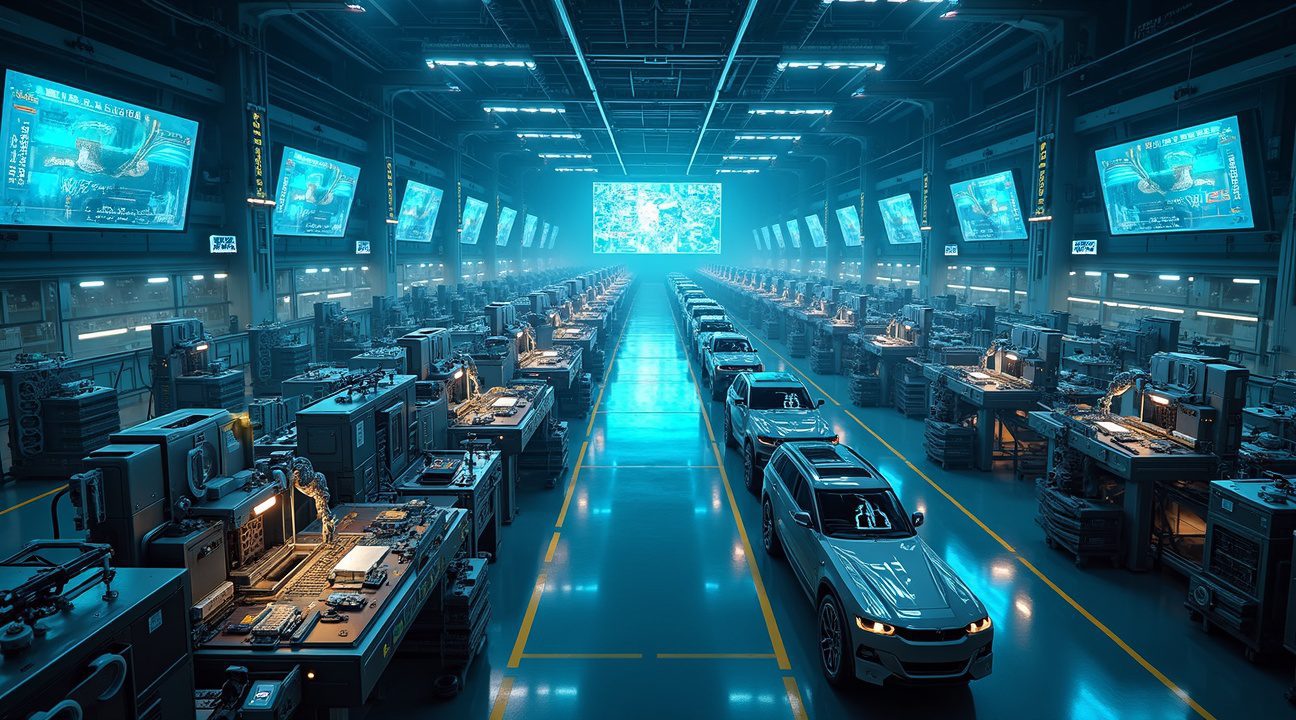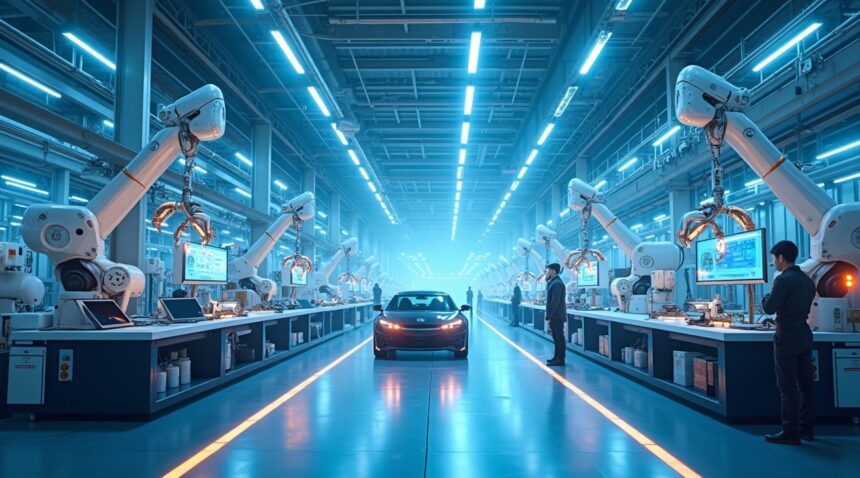China deployed 300,000 new industrial robots in 2024, dramatically outpacing the combined efforts of all other nations and solidifying its position as the global automation leader.
This massive expansion brings China’s total operational robot workforce to over 2 million units, representing more than half of all industrial robots worldwide.
Key Takeaways
- China installed nearly 300,000 robots in 2024, dwarfing the combined installations of the United States (34,000) and Japan (44,000).
- Domestic Chinese robot manufacturers now supply 60% of new installations, up from just 28% market share in the previous decade.
- Electronics and automotive sectors drive this growth, with China capturing 62% of global electronics robot installations and 48% of automotive robot deployments.
- The Made in China 2025 policy provides strategic government backing through subsidies and coordinated industrial planning to accelerate robotic adoption.
- China’s automation boom creates high-paying technical jobs with robot specialists earning up to $60,000 annually, though 38% of businesses report talent shortages in specialized roles.
A New Era of Industrial Transformation
China’s robotic revolution represents the largest industrial transformation since the country’s initial manufacturing boom. The nation’s commitment to automation extends far beyond simple production numbers. Chinese companies have fundamentally shifted their approach to manufacturing, embracing advanced robotics as the cornerstone of future competitiveness.
Electronics and Automotive at the Forefront
The electronics sector leads this charge, with companies like Foxconn and BYD deploying thousands of robots monthly. These manufacturers recognize that precision assembly and quality control demand robotic solutions. Human workers simply cannot match the consistency and speed required for modern electronics production. Automotive manufacturers follow closely behind, with both domestic brands like Geely and international companies like Tesla expanding their robotic operations on Chinese soil.
Rise of Domestic Robotics Manufacturers
Domestic robot manufacturers have achieved remarkable growth in capability and market share. Companies such as SIASUN and Estun have developed sophisticated robotic systems that rival established international brands. The quality gap between Chinese and foreign robots has narrowed significantly, while cost advantages remain substantial. Local manufacturers can deliver customized solutions faster and provide superior after-sales support compared to international competitors.
The Role of Government Policies
Government policy plays a crucial role in this expansion. The Made in China 2025 initiative provides direct financial incentives for companies adopting robotic systems. Local governments offer additional subsidies, tax breaks, and preferential lending terms for automation projects. This coordinated support creates an environment where robotic adoption becomes financially attractive even for smaller manufacturers.
Impact on the Workforce
The workforce implications of this robotic surge present both opportunities and challenges. Traditional assembly line positions are disappearing, but new roles emerge requiring advanced technical skills. Robot programmers, maintenance technicians, and system integrators command premium salaries in China’s evolving job market. Educational institutions are rapidly developing programs to train workers for these emerging positions.
However, the talent gap remains significant. Companies struggle to find qualified personnel who can program, maintain, and optimize robotic systems. This shortage has created intense competition for skilled workers and driven up wages in technical fields. Many manufacturers are partnering with vocational schools and universities to develop custom training programs.
Geographic Shift and Technological Advancement
Regional Expansion
Regional distribution of robotic installations reveals interesting patterns. The Pearl River Delta continues to lead in absolute numbers, but inland provinces are catching up rapidly. Manufacturers relocating to lower-cost regions bring robotic technology with them, spreading automation beyond traditional industrial centers. This geographic expansion accelerates the overall pace of adoption.
Smarter Robots, Better Performance
The technology sophistication of newly installed robots has improved dramatically. Earlier deployments focused on simple pick-and-place operations and basic assembly tasks. Current installations incorporate advanced vision systems, artificial intelligence, and collaborative capabilities. These robots can adapt to changing production requirements and work safely alongside human operators.
Quality Improvements and Cost Efficiency
Quality improvements represent another significant benefit of increased robotic adoption. Automated systems reduce defect rates and improve consistency across production runs. Chinese manufacturers use these quality gains to compete more effectively in premium markets where precision matters most. Electronics companies particularly benefit from the enhanced precision that robotic assembly provides.
Cost reduction remains a primary driver for robotic adoption, but the calculation has evolved beyond simple labor savings. Modern robots reduce material waste, improve energy efficiency, and enable lights-out production capabilities. These operational improvements often exceed direct labor cost savings in terms of overall impact on profitability.
Global Implications
International implications of China’s robotic leadership extend beyond manufacturing competitiveness. The rapid development of domestic robot manufacturers creates new export opportunities while reducing dependence on foreign technology. Chinese robot companies are beginning to compete internationally, offering cost-effective solutions to manufacturers worldwide.
The acceleration shows no signs of slowing down. Industry projections suggest China will install over 400,000 robots annually by 2027, further extending its global leadership position. This growth trajectory will likely reshape global manufacturing patterns and supply chain strategies for years to come.
Robotics and Supply Chain Strategy
Supply chain considerations have become increasingly important as companies recognize the strategic value of robotic manufacturing capabilities. The ability to quickly reconfigure production lines and maintain operations during disruptions has proven invaluable. Robotic systems provided crucial flexibility during recent global supply chain challenges.
Environmental Impacts
Environmental benefits accompany the efficiency gains from robotic adoption. Automated systems typically consume less energy per unit produced and generate less waste than manual operations. These improvements help Chinese manufacturers meet increasingly strict environmental regulations while maintaining competitive production costs.
Conclusion: A New Industrial Blueprint
The transformation of China’s manufacturing sector through robotics represents more than technological advancement – it signals a fundamental shift in how the nation approaches industrial competition. By combining government support, domestic innovation, and strategic implementation, China has created a sustainable model for manufacturing leadership in the automated age.
China Commands Over 2 Million Industrial Robots, More Than Rest of World Combined
China’s industrial automation landscape has reached unprecedented levels, with over 2 million industrial robots operating in Chinese factories by 2024. This massive deployment represents more operational units than the rest of the world combined, establishing China as the undisputed leader in artificial intelligence and robotic automation.
The numbers paint a striking picture of China’s dominance in the global robot market. With total global operational industrial robots reaching 4,664,000 in 2024, China’s share has expanded from one-quarter to one-third of the entire market within just one year. This dramatic increase reflects the country’s aggressive push into automation across manufacturing sectors.
Market Share Expansion Drives Global Transformation
China’s robot workforce continues to outpace international competitors at an extraordinary rate. The country’s strategic investment in automation technology has created a manufacturing ecosystem where robots handle everything from precision assembly to complex logistics operations. Traditional manufacturing hubs struggle to match this scale of robotic integration.
Several factors contribute to China’s robot army growth:
- Government subsidies and policies promoting industrial automation
- Lower implementation costs compared to Western markets
- Rapid adoption across electronics, automotive, and consumer goods sectors
- Integration with advanced AI systems for enhanced productivity
- Strategic partnerships between Chinese manufacturers and robot suppliers
This massive deployment affects global supply chains and competitive dynamics. International manufacturers face pressure to accelerate their own automation initiatives to remain competitive. However, the scale and speed of China’s robotic transformation create challenges for other nations attempting to match this pace.
The concentration of industrial robots in China also influences technological development priorities worldwide. Robot manufacturers increasingly design systems specifically for Chinese market requirements, which then become global standards. This shift in development focus reflects China’s purchasing power and influence in shaping future automation technologies.
Manufacturing executives worldwide monitor China’s robot deployment strategies closely. The country’s success in integrating millions of robots into production lines provides valuable insights for automation planning. Yet the sheer scale of China’s robot workforce creates unique operational challenges that smaller markets may not encounter.
China’s dominance in industrial robotics extends beyond simple numbers. The integration of unprecedented AI investment with robotic systems creates sophisticated manufacturing capabilities that competitors find difficult to replicate quickly.

Nearly 300,000 New Robots Added in Single Year Dwarfs Global Competition
China’s robotic expansion has reached unprecedented levels, with nearly 300,000 new robots installed throughout 2024. This staggering figure doesn’t just represent growth—it completely overshadows every other nation’s efforts combined. I find these numbers particularly striking when considering how rapidly China has accelerated its artificial intelligence integration across manufacturing and industrial sectors.
Global Installation Comparison Reveals Massive Gap
The scale becomes even more apparent when examining direct comparisons with other major economies. The United States managed to add 34,000 robots during the same period, while Japan installed 44,000 units. Even combining these two industrial powerhouses results in just 78,000 installations—roughly one-quarter of China’s output. This disparity highlights China’s commitment to automation that extends far beyond traditional manufacturing into sectors like logistics, healthcare, and consumer services.
Several factors contribute to this remarkable acceleration in robot installations:
- China’s expanding manufacturing base continues upgrading its facilities with advanced automation.
- Proactive government incentives and policies encourage the adoption of robotic solutions.
- Strong AI infrastructure as showcased by China’s unprecedented AI investment, providing the necessary backbone for sophisticated robotics.
Historical Context and Market Dominance
China’s dominance isn’t entirely new, though the current pace represents an acceleration. The country accounted for 51% of global robot installations in 2023, establishing a clear leadership position that has only strengthened. This 2024 figure represents the second-highest annual installation count ever recorded, suggesting that China’s robotic expansion continues pushing boundaries previously thought unattainable.
I observe that this growth pattern reflects broader economic strategies rather than simply following market trends. China’s approach integrates robotic deployment with comprehensive industrial modernization plans. Companies aren’t just replacing human workers—they’re reimagining entire production processes around automated systems. This strategic thinking explains why installation numbers continue climbing even as global economic conditions fluctuate.
The ripple effects extend beyond manufacturing floors. China’s robot installations influence global supply chains, competitive dynamics, and technological development priorities. When one nation deploys automation at this scale, it creates pressure for trading partners and competitors to accelerate their own modernization efforts or risk falling behind in productivity and cost competitiveness.
These installation figures also reflect China’s position as both a major consumer and producer of robotic technology. Domestic companies like BYD and Foxconn deploy thousands of units annually, while Chinese robotics manufacturers gain valuable experience and market feedback that drives further innovation. This creates a positive feedback loop where increased deployment leads to better technology, which enables even more widespread adoption.
The geographic distribution of these installations spans multiple regions within China, from traditional manufacturing hubs in Guangdong and Jiangsu to emerging industrial centers in central and western provinces. This broad deployment suggests that robotic adoption isn’t concentrated in a few major cities but represents a nationwide transformation of industrial capabilities.
Looking at specific sectors, automotive manufacturing continues leading robot installations, followed closely by electronics and consumer goods production. However, I notice growing adoption in previously human-dependent areas like food processing, textiles, and even service industries. This diversification indicates that China’s robotic revolution extends well beyond heavy manufacturing into virtually every aspect of economic activity.
The annual growth rate implied by these numbers suggests that China’s robot installations could exceed 400,000 units within the next few years if current trends continue. Such expansion would further cement China’s position as the undisputed leader in industrial automation while potentially creating even larger gaps with competing nations. This trajectory positions China not just as a manufacturing powerhouse but as a testing ground for next-generation robotic technologies that could define global industrial standards for decades to come.

Made in China 2025 Policy Drives Domestic Robot Revolution
China’s strategic approach to robotics development stems directly from the Made in China 2025 policy, launched in 2015 with ambitious goals to transform the nation’s manufacturing capabilities. I recognize this industrial policy as a pivotal moment that identified robotics as a critical sector for national economic advancement. The government’s commitment wasn’t merely rhetorical—it backed this vision with substantial financial support through subsidies, loans, and direct funding mechanisms.
Strategic Government Investment Accelerates Market Growth
The state-driven policy framework gained significant momentum in 2021 when Chinese authorities issued a comprehensive robot deployment strategy. This accelerated adoption rates across multiple industries, creating a ripple effect throughout the domestic manufacturing ecosystem. I’ve observed how this coordinated approach differs markedly from market-driven strategies employed elsewhere, as China signals unprecedented AI investment across related technologies.
Government investment flowed into research institutions, manufacturing facilities, and technology development programs. These financial incentives reduced barriers for companies seeking to integrate robotic systems into their operations. Local manufacturers received preferential treatment, enabling them to compete more effectively against established international players.
Domestic Market Share Transformation
The results of this focused industrial policy became evident through dramatic shifts in market dynamics. Domestic robot market share surged from just 28% in the previous decade to an impressive 47% in 2023. This transformation didn’t happen overnight—it required sustained effort and strategic coordination between government agencies and private enterprises.
By 2024, domestically produced robots accounted for nearly three-fifths of all installations within China’s borders. This remarkable achievement demonstrates how targeted policy interventions can reshape entire industries. I find it particularly noteworthy that this growth occurred while global competition intensified and technological complexity increased.
The success of Chinese robotics companies has implications beyond domestic borders:
- Japan’s share of global robot manufacturing dropped to 29% in 2024.
- This reflects increasing competitive pressure from China’s expanding capabilities.
- The shift symbolizes more than market reallocation—it indicates a change in global manufacturing leadership.
Chinese manufacturers didn’t simply copy existing technologies; they developed innovative solutions adapted to local market needs. This approach enabled them to create products that resonated with domestic users while building expertise for international expansion. The combination of government support and market-focused innovation created a powerful foundation for sustained growth.
The Made in China 2025 policy’s emphasis on domestic supply chains proved particularly valuable during global disruptions. Companies with local suppliers maintained more stable operations, while those dependent on international sources faced challenges. This resilience factor reinforced the strategic wisdom of developing comprehensive domestic capabilities.
Technology transfer requirements for foreign companies operating in China also contributed to knowledge diffusion throughout the domestic robotics ecosystem. These policies ensured that international expertise became integrated with local innovation capacity, creating hybrid approaches that leveraged global best practices while addressing specific Chinese market requirements.
The success of this domestic robot revolution extends beyond manufacturing statistics. It represents a fundamental shift in how nations can leverage coordinated industrial policy to achieve technological leadership. Artificial intelligence paving the way for the future becomes more achievable when supported by comprehensive government strategies.
I recognize that this transformation continues to evolve, with implications reaching far beyond China’s borders. The combination of strategic planning, financial support, and market development has created a template that other nations study carefully as they develop their own robotics capabilities.
https://www.youtube.com/watch?v=3CMiSK8NHEo
Electronics and Automotive Sectors Lead Robot Deployment Transformation
China’s industrial automation has reached unprecedented levels, with two sectors driving this massive expansion. The country’s electronics and automotive industries have become the primary battlegrounds for robotic integration, fundamentally reshaping global manufacturing patterns.
Electronics Industry Dominates Global Robot Installations
The electrical and electronics sector stands as China’s automation powerhouse, installing 77,464 robots in 2023 alone. This staggering figure represents 62% of all global electronics industry robot installations, demonstrating China’s overwhelming dominance in this space. Chinese suppliers have stepped up significantly, providing 54% of these installations and challenging established international manufacturers.
Robots in electronics manufacturing handle increasingly sophisticated tasks. These machines excel at delicate assembly operations, precision component placement, and quality control inspections. The miniaturization of electronic components demands extreme accuracy, making robotic systems essential for maintaining competitive production speeds while ensuring quality standards.
Automotive Sector Accelerates Robotic Integration
China’s automotive industry installed 64,882 robots in 2023, capturing 48% of global automotive robot installations. While international companies continue to supply the majority of these systems, domestic firms are rapidly expanding their market presence and technical capabilities.
Automotive robots perform critical functions that transform production efficiency:
- Heavy lifting operations for vehicle frames and major components
- Precision welding for structural integrity and safety compliance
- Complex assembly tasks requiring consistent repeatability
- Loading products onto conveyor belts for streamlined production flow
The automotive sector’s robot adoption reflects China’s push to become a global leader in electric vehicle production. Self-driving cars require even more precise manufacturing standards, driving additional demand for advanced robotic systems.
International suppliers maintain their edge through superior technology and established relationships with major automakers. However, Chinese manufacturers are investing heavily in research and development, gradually closing the technical gap. This competition benefits the entire industry by driving innovation and reducing costs.
The transformation extends beyond simple automation. Modern industrial robots integrate with artificial intelligence systems, enabling adaptive manufacturing processes that respond to changing production requirements. This flexibility proves crucial in electronics manufacturing, where product lifecycles continue shrinking and customization demands increase.
Both sectors showcase China’s commitment to maintaining manufacturing leadership through technological advancement. The rapid adoption of robotic systems positions Chinese manufacturers to compete effectively in global markets while addressing domestic labor shortages and rising wage costs.
AI Integration Creates High-Paying Tech Jobs While Facing Talent Shortages
China’s robotics boom extends far beyond physical machinery installation. The country’s emphasis on artificial intelligence integration transforms how these mechanical workers operate and interact with human counterparts. Manufacturing facilities across the nation deploy sophisticated AI systems that optimize robot performance, track operational metrics in real-time, and enable predictive maintenance protocols that prevent costly equipment failures.
The transformation proves comprehensive. More than 90% of Chinese organizations view AI and robotics as essential components for business transformation, fundamentally reshaping how companies approach production challenges. This integration creates feedback loops where AI systems learn from robot performance data, continuously improving efficiency and reducing waste in manufacturing processes.
Technical Roles Command Premium Salaries
The workforce demands have shifted dramatically as robotics integration accelerates. Traditional manufacturing roles evolve into highly technical positions requiring specialized knowledge in electrical systems, programming languages, and mechanical engineering. Companies actively seek skilled electricians who understand both traditional wiring and advanced sensor networks that connect robots to centralized AI systems.
Robot installation specialists now earn salaries approaching $60,000 per year, reflecting the premium placed on technical expertise. These professionals must understand multiple programming languages, mechanical systems, and safety protocols while adapting to rapidly changing technological requirements. Engineers specializing in robotics integration command even higher compensation packages, particularly those with experience in AI implementation and manufacturing optimization.
Programming roles have multiplied as companies require custom software solutions for their robotic systems. These positions demand knowledge of machine learning algorithms, data analysis, and industrial automation protocols. Maintenance technicians skilled in predictive analytics and sensor technology find themselves increasingly valuable as companies recognize the cost savings associated with preventing equipment failures rather than responding to breakdowns.
The talent shortage creates opportunities for rapid career advancement. Despite China’s strong technical education foundation, 38% of businesses report significant gaps in specialist roles required for robotics integration. This shortage drives up compensation across technical positions while creating pathways for workers willing to develop relevant skills through reskilling programs.
The labor market transformation extends beyond individual roles. Companies invest heavily in training programs that help existing employees transition from manual tasks to technical supervision and maintenance responsibilities. These initiatives recognize that successful robotics implementation requires human expertise in oversight, troubleshooting, and continuous improvement processes.
Digitalization efforts require workers who can interpret data streams from multiple robotic systems, identify optimization opportunities, and implement software updates that enhance performance. The most successful professionals combine technical knowledge with practical understanding of manufacturing processes, enabling them to bridge the gap between AI capabilities and production requirements.
The workforce transition creates a multiplier effect throughout related industries. As robotics specialists command higher salaries, supporting roles in logistics, quality control, and system integration also experience wage growth. Companies compete for talent by offering:
- Comprehensive benefits packages
- Professional development opportunities
- Flexible working arrangements that accommodate the technical nature of these positions
Training institutions respond by developing specialized curricula that address current industry demands. Partnership programs between manufacturers and technical schools create direct pathways for students to enter high-paying robotics careers upon graduation. These collaborations ensure that new graduates possess practical skills aligned with employer requirements rather than purely theoretical knowledge.
The economic impact ripples beyond individual compensation. Higher-paying technical roles increase local spending power, supporting service industries and contributing to regional economic growth. Communities that successfully attract robotics manufacturing facilities often experience broader economic development as supporting businesses emerge to serve the skilled workforce requirements.
China’s approach demonstrates how technological advancement can create economic opportunities while addressing traditional concerns about automation displacing workers. The key lies in recognizing that advanced robotics systems require sophisticated human oversight, creating new categories of employment that offer both intellectual challenge and financial rewards for those willing to develop relevant technical expertise.
Domestic Companies Like Unitree Robotics Challenge Global Manufacturers
Chinese companies are rapidly transforming the robotics landscape, with firms like Unitree Robotics leading the charge in developing cost-effective humanoid robots that directly compete with established international manufacturers. Based in Hangzhou, Unitree Robotics has emerged as a prime example of how domestic innovation is reshaping the market dynamics.
The shift from import dependence to domestic production represents a dramatic change in China’s robotics sector. Previously, most robots operating in Chinese facilities came from foreign manufacturers, but this pattern has reversed significantly. By 2024, nearly 60% of newly installed robots were domestically produced, marking a clear trend in artificial intelligence development and manufacturing capabilities.
Competitive Pricing Drives Market Disruption
Chinese manufacturers have gained substantial market share by offering robots at significantly lower prices than their international counterparts. This pricing strategy has proven particularly effective in industries where cost considerations play a crucial role in automation decisions. Companies like Unitree Robotics have demonstrated that affordable doesn’t necessarily mean inferior quality, as their products increasingly match the performance standards of more expensive alternatives.
The rapid progress in domestic robotics production has been supported by substantial state backing and strategic investment in innovation. Government initiatives have accelerated research and development efforts, enabling Chinese companies to reduce production costs while maintaining competitive technical specifications. This support has allowed domestic manufacturers to scale operations quickly and establish strong market positions.
Despite these advances, China still faces challenges in certain high-tech components. Advanced sensors and semiconductors remain largely imported, creating dependencies on foreign suppliers for critical robot subsystems. However, the gap in these technologies continues to narrow as Chinese companies invest heavily in developing indigenous capabilities for these sophisticated components.
The impact extends beyond simple import substitution. Chinese robotics companies are increasingly competing in international markets, leveraging their cost advantages and improving technical capabilities. This expansion has prompted global manufacturers to reassess their pricing strategies and production methods to maintain competitiveness.
Innovation cycles in China’s robotics sector have accelerated dramatically, with companies releasing new models and upgraded capabilities at unprecedented rates. This rapid development pace has been particularly evident in autonomous technology integration and human-robot interaction systems.
The transformation reflects broader changes in China’s technological landscape, where domestic companies are moving from manufacturing low-cost products to developing sophisticated technologies that challenge established global leaders. Success stories like Unitree Robotics demonstrate how focused innovation efforts can disrupt traditional market hierarchies and create new competitive dynamics in advanced technology sectors.
Sources:
International Federation of Robotics; “China Surges Ahead With World’s Largest Robot Workforce” (Evrim Ağacı)
ZME Science; “China Now Has More Factory Robots Than the Rest of the World Combined”
Convergence Now; “The Rise of China’s Robot Workforce: 2 Million and Counting”
World Economic Forum; “Future of Jobs Report 2025”
International Federation of Robotics; “World Robotics 2024 – China” (press release)


